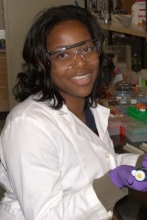
University:
Jackson State University
Major:
Chemistry
Mentor(s):
Joanna Deek
Faculty Sponsor(s):
Cyrus R. Safinya
Faculty Sponsor's Department(s):
Cellular, Molecular and Developmental Biology
Project Title:
SALT DEPENDENCE OF NEUROFILAMENT GEL PHASE BEHAVIOR
Project Description:
Neurofilament proteins (NFs) are believed to be involved in the maintenance of neuronal cell
function and structure, and are present within the cytoskeleton of neuronal cells. The
accumulation of NFs in the neuronal cell axons of the diseased cells inhibit transportation of
particles through the axon; this eventually results in neuronal cell death. NFs self-assemble to
form the extended filament with 10nm diameter and are classified into 3 subunits: NF-Low, NFMedium,
and NF-High, this is dependent by the relative length of their tail domains and have
corresponding molecular weights of 63kDa, 105kDa, and 125kDa. By studying the NF network
assembly and interactions the electrostatic attraction or repulsion between NFs is able to be
altered using various salt concentrations. Increased monovalent and divalent salt
concentrations in the reassembly buffer, in addition to sidearm interactions, have been
implicated in more extensive longitudinal growth of the filaments. Crude protein containing NFs
must be separated starting from subunits isolated using anion exchange. NF Phase behavior is
characterized by optical microscopy, Transmission Electron Microscope, and Small X-ray
Scattering. NF-Medium and NF-High behave differently due to variant inherent charge. By
using a harged system, salts allow us to probe their interactions and total effective charge.
